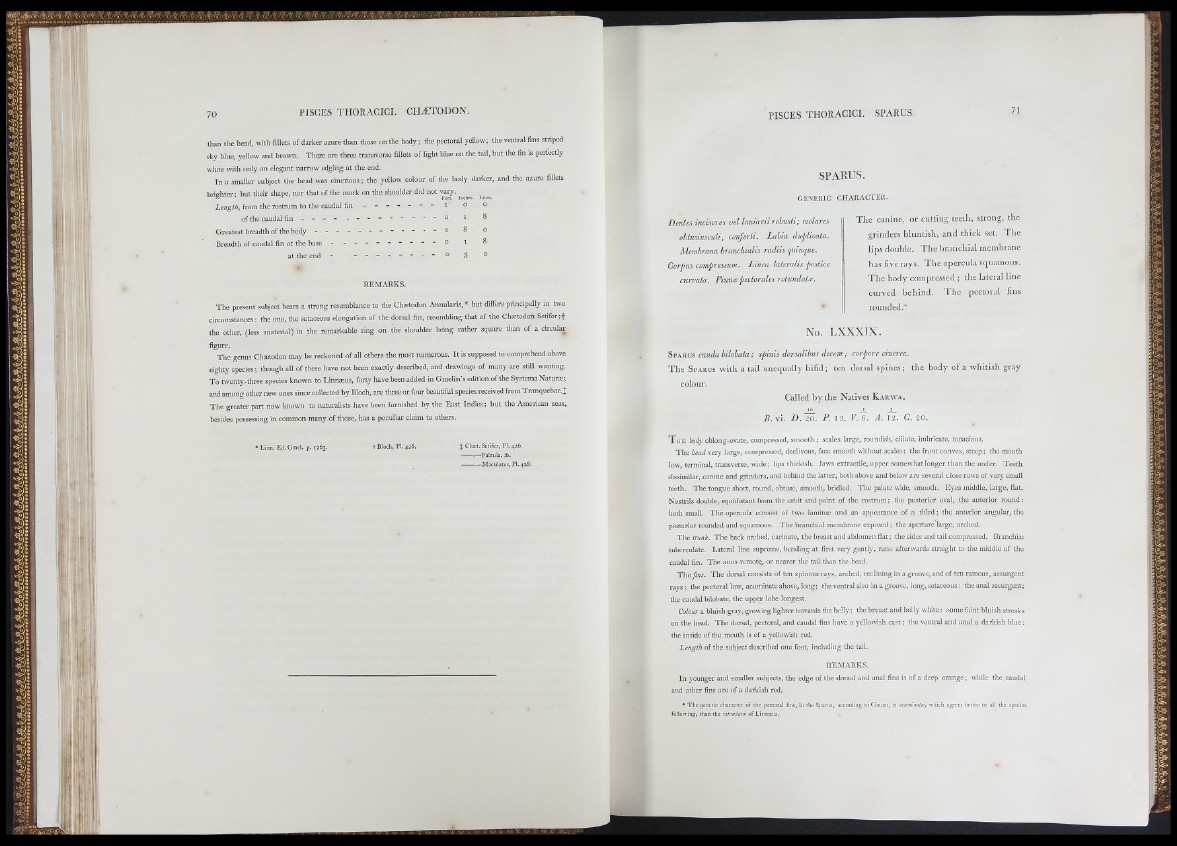
than the head, vvith fillets o f darker azure than those on the body; the pectoral yellow; the ventral fins striped
sky blue, yellow and brown. The re are three transverse fillets of light blue on the tail, but the fin is perfectly
white with only an elegant narrow edging at the end.
In a smaller subject the head was cinerious; the yellow colour of the body darker, and the azure fillets
brigliter; but their shape, nor that of tiie mark on the shoulder did not v ajy .
Length, from tlie rostrum to the caudal f i n - - - - - - - i ° °
o f the caudal f i n ..............................................................................- ° t 8
Greatest breadth o f the body - - o 8 o
Breadth o f caudal fin at the base - - - - - - - - - - o i 8
at the e n d ............................................................................................... S °
T h e present subject bears a strong resemblance to the Chastodon Annularis,» but differs principally in two
circumstances ; the one, the setaceous elongation of the dorsal fin, resembling that o f the Chtetodon Setifer;-|-
the other, (less material) in the remarkable ring on the shoulder being rather square than o f a circular
figure.
T h e genus Chatodon may be reckoned o f all others the most numerous. It is supposed to comprehend above
eighty species; though all o f these have not been exactly described, and drawings o f many are still wanting.
T o twenty-three species known to Linnaus, forty have been added in Graeliii’s edition of the SystemaNatura;
and among other new ones since collected b y Bloch, are three or four beautiful species received from Tranquebar.X
T h e greater part now known to naturalists have been furnished by the East Indies; but the American seas,
besides possessing in common many of those, has a peculiar claim to others.
• Linn. Ed. Gmel. p. 1263. X Chæt. Setifer, PI. 426.
— — Falcula, ib.
Maculatus, PI. 428.
SPARUS.
GENERIC CH A R A C T ER .
Denies incisores vel laniarii robusti; molares
ohtusiusculi, conferii. Labia duplicata.
Membrana branchialis radiis quinque.
Corpus compressum. Linea lateralis postice
curvata. Pinna pectorales rolundata.
T h e can in e, o r cu ttin g teeth , stro n g , the
grin d ers b lu n tish , a n d th ic k set. T h e
lip s dou b le. T h e b ran c liia l m em b ran e
has five rays. T h e o p ercu la squamou,s.
T h e b o d y compressed ; the lateral lin e
cu rv ed b e h in d . T h e pe c to ra l fins
rounded.*
No. LXXXTX.
S p a r u s cauda hilobata; spinis dorsalibus decern; corpore cinereo.
T h e S parus w i t h a t a i l u n e q u a l ly b i f id ; te n d o rs a l s p in e s ; th e b o d y o f a w h i t i s h g r a y
co lo u r.
C a lle d b y th e N a tiv e s K a r w a .
Z . v i . D . 2 Ô. P. 13. K g ’, a . iT . C. 2 0 .
T h e body oblong-ovate, compressed, smooth ; scales large, roundish, ciliate, imbricate, tenacious.
T h e head very large, compressed, declivous, face smooth without scales ; the front convex, steep ; the mouth
low, terminal, transverse, wide ; lips thickish. Jaws extractile, upper somewhat longer than the under. T eeth
dissimilar, canine and grinders, and behind the latter, both above and below are several close rows o f very small
teeth. T h e tongue short, round, obtuse, smooth, bridled. T h e palate wide, smooth. Eyes middle, large, flat.
Nostrils double, equidistant from the orbit and point o f the rostrum; the posterior oval, the anterior round:
both small. T h e opercula consist o f two laminæ and an appearance o f a third; the anterior angular, the
posterior rounded and squamous. T h e branchial membrane exposed ; the aperture large, arclied.
T h e trunk. The back arched, carinate, the breast and abdomen flat ; the sides and tail compressed. Branchiæ
tuberculate. Lateral line supreme, bending at first very gently, runs afterwards straight to the middle o f the
caudal fin. T h e anus remote, or nearer tlie tail tlian the head.
T h t fin s . T h e dorsal consists of ten spinous rays, arched, reclining in a groove, and of ten ramous, assurgent
rays ; the pectoral low, acuminate above, long; the ventral also in a groove, long, setaceous ; the anal assurgent;
the caudal bilobate, the upper lobe longest.
Colour a bluish gray, growing lighter towards the belly ; the breast and belly white ; some faint bluish streaks
on the head. T h e dorsal, pectoral, and caudal fins have a yellowish cast; the ventral and anal a darkish blue;
the inside of the mouth is of a yellowisli red.
Length of the subject described one foot, including the tail.
R EM A R K S .
e of the dorsal and anal fins is of a deep o range;In younger and smaller subjects, the e while the caudal
and other fins are of a darkish red.
• The generic character of the pectoral fins, ¡11 the Sparus, according to Gouan, is acuminata, which agrees better to all the species
following, than the rolundata of Linnajus.